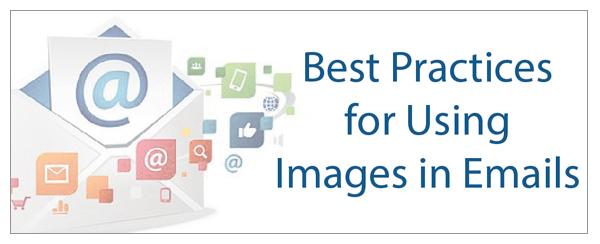Best Practices for Using Images in Emails
Email campaigns are one of the best ways to reach your market, if they are done correctly. Here are some tips to follow to increase your return on investment.

Email Campaign Best Practices
1. Limit the Use of Images in the Top Two Inches of Your Email
Most subscribers scan your email to decide if they want to read it. This happens in the preview panel. That means you have two inches and 30 seconds to convince a subscriber to continue reading. You need to be sure to get compelling text into the top two inches of your email template in order to get your audience to open it. If you are using an image, the size is usually 700 pixels across and no more than 75 pixels in height. Be sure to incorporate a small, but engaging, graphic in the top two inches of your email template. The most important message in your email needs to be in the top two inches.
2. Never Send an Email That Is One Big Image or All Images
Although that single image may be visually amazing, it doesn’t matter if no one sees it. The only fact you need to worry about is that half of the people to whom you sent the email never saw the graphic. Not only did the image not load when they opened their email, but because there was no text in the top two inches telling them why it was important, they never downloaded your images at all.
3. Don’t Trap Important Messages or Links in Images
For the reasons above, avoid sending emails that are entirely image files. You also want to avoid trapping critical messages in image files they may never see. Links in email templates should always be 6:00 text links. If you really want to use a graphic button to indicate a place to click, you should always include a text link below it. What’s the basic rule? If it’s something your readers or subscribers absolutely need to know, it needs to be in text, even if that text is in addition to a graphic.
4. Always Provide Alt and Title Text
Alt text is the html coded text that appears when an image doesn’t load. Title text is the hover text that appears when a user passes their mouse over an image. However, in some web browsers, such as Firefox, title text is used in the same way that alt text is. Why are alt text and title text important to you? Since at least half of your subscribers will not see your image files, they will not get that message. For those images that don’t load, seeing an alternative piece of text that describes the image means you have not wasted the space in your email. You’ve used the space to convey an important message, even if the image didn’t load.
The Penguin Suits Difference
Penguin Suits knows that your business is unique and special, so we treat you and your business like you are our only client. We promise to develop a relationship of unmatched trust and confidence as Your Marketing Department. We pledge to create an effective lead generation campaign especially for your business that is creative, daring, passionate, and consistent. You will be proud to put your name on the marketing campaigns Penguin Suits creates for you.
Of course, what you write for your title and alt text is equally important. Have your title be a call-to-action to enhance the message of your email. It’s our belief that, given the speed with which users will scan your email, you will get better results by using the alt and title text to incite direct action.
5. Thirty Percent is a Good Rule
What’s a basic, good rule to follow when designing an email template? Only use about thirty percent of your available space for images. Thirty percent means that you’ll still have enough images to entice users, but you won’t be in danger of either creating spam problems for yourself or your subscriber. Keep in mind: Email does not operate like a print collateral piece, or like a webpage. It has usability and functionality issues that require design adaptations.
6. Do Not Make Images Files Too Large
Finally, for the email images that you do use in your email template, avoid making the files too large. This is not only from a space perspective, but large image files can create significant spam and email deliverability issues. Small, compressed, well-formatted images are the key to the successful use of email images.
In summary, remember all the following key points when deciding to use image in your email templates:
- Do not overuse images in the critical top two inches of your email
- Do not send emails that are entirely comprised of images
- Do not trap important calls to action in images
- Always provide alt text and title text for your images
- Do not devote more than thirty percent of your email to images
- Keep image files small, compressed, and optimize
Images are an important part of a successful email template. Simply follow the best practices above, and you’ll be sure to find the middle ground between images that enhance your email template performance and images that create email deliverability and performance issues. I hope these marketing tips make your campaigns more effective.
If you have any questions, contact Penguin Suits. We are Your Marketing Department and we are here to help.